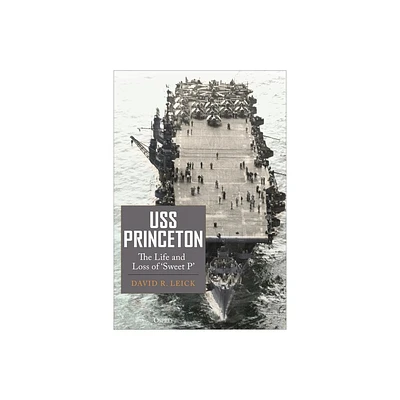Home
USS Princeton: The Life and Loss of "Sweet P"
Loading Inventory...
Barnes and Noble
USS Princeton: The Life and Loss of "Sweet P"
Current price: $35.00


Barnes and Noble
USS Princeton: The Life and Loss of "Sweet P"
Current price: $35.00
Loading Inventory...
Size: Hardcover
*Product Information may vary - to confirm product availability, pricing, and additional information please contact Barnes and Noble
An in-depth history of the US Navy's light aircraft carrier the USS
Princeton
and its operational exploits in the Pacific Theater of World War II.
This new history of the life and loss of USS
tells the story of the new class of aircraft carrier that proved essential to the US Navy's victory over the Imperial Japanese Navy in the Pacific War.
USS
(CVL-23) started life as the light cruiser
Tallahassee
before being converted while still under construction into a light carrier as part of the plan to ramp up the strength of US naval air power. The vessel joined the Pacific Fleet in August 1943 and was immediately put to work as the United States was assembling new ships and crews for the bitter struggle to come.
played a key role in conducting multiple strikes against the Japanese bastion at Rabaul, and then joined Task Force 58/38 – the Fast Carrier Task Force – for the Central Pacific campaign, culminating in the invasion of the Philippines, where the ship was lost.
David R. Leick skillfully uses first-hand accounts to examine the engagements, aircraft, tactics, command decisions and life on board during the Pacific campaign against Japan from early 1943 until
's tragic demise in October 1944. He focuses closely on the ship's crew and embarked Naval Aviators, describing in detail the toll that prolonged combat operations took on the frontline sailor.
Princeton
and its operational exploits in the Pacific Theater of World War II.
This new history of the life and loss of USS
tells the story of the new class of aircraft carrier that proved essential to the US Navy's victory over the Imperial Japanese Navy in the Pacific War.
USS
(CVL-23) started life as the light cruiser
Tallahassee
before being converted while still under construction into a light carrier as part of the plan to ramp up the strength of US naval air power. The vessel joined the Pacific Fleet in August 1943 and was immediately put to work as the United States was assembling new ships and crews for the bitter struggle to come.
played a key role in conducting multiple strikes against the Japanese bastion at Rabaul, and then joined Task Force 58/38 – the Fast Carrier Task Force – for the Central Pacific campaign, culminating in the invasion of the Philippines, where the ship was lost.
David R. Leick skillfully uses first-hand accounts to examine the engagements, aircraft, tactics, command decisions and life on board during the Pacific campaign against Japan from early 1943 until
's tragic demise in October 1944. He focuses closely on the ship's crew and embarked Naval Aviators, describing in detail the toll that prolonged combat operations took on the frontline sailor.


















